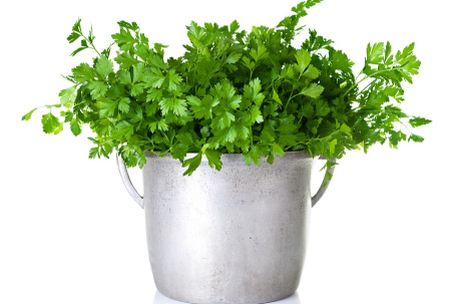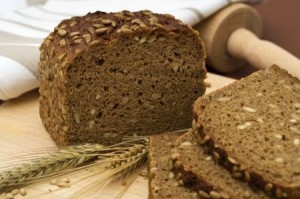Who’d have thought? The parsley found in almost any kitchen may benefit heart and kidney disease, assist indigestion, and prevent gynecological problems. This is how the modest parsley contributes to your health. Give it the respect it deserves!

Admit it. You didn’t know that parsley is a true health bomb. In a salad, a dip, a soup, or a casserole, parsley finds its way into almost every kind of kitchen. You love it for its taste and cheap price, but few people actually know how healthy it really is.
Parsley has been around for more than 2,000 years and served as a medication long before it was used as something you add to your food. The ancient Greeks attributed health properties to parsley and used it to strengthen athletes. The Romans even attributed magical powers to parsley to ward off drunkeness.
In time, the Mediterranean kitchen discovered parsley’s attributes and used it to enrich the taste of the food. Since then, throughout history parsley has been used as a food, a spice, and as medicine, and has survived in the modern-day kitchen.
Its integration was so popular and natural that the increase in its consumption had no connection to its medicinal properties. And, by the way, parsley has other uses outside the kitchen. The oils found in the plants’ seeds can be used to create a fragrance for perfume, soap, and crèmes.
The absurd thing is that in the western world, which puts such emphasis on eating healthy, especially in restaurants, parsley is used mainly as a garnish, separated from the food served, and tossed away while eating the course.
What does parsley contain?
The nutritional profile of parsley includes a diverse variety of vitamins, minerals, phytochemicals, and essential oils, and a density level (meaning the level of relevant efficiency) between good and excellent. Hidden in ¼ cup (15g) of parsley, containing approximately 5 calories:
- Notable levels of vitamins: approximately 25% of the daily requirement for vitamin C, 7% for vitamin A, and 6% folic acid
- Notable levels of minerals: over 10% of the daily requirement for iron, and 2% for potassium, calcium, and magnesium
- 13% the amount of beta carotene in a large carrot and vitamin C in an orange
Along with the impressive variety of vitamins and minerals, parsley is also loaded with essential oils. Many important compounds in parsley have been found in scientific studies to be associated with genuine medicinal-like qualities.
Heart disease: may reduce the risk of heart disease and may reduce blood pressure
Blood vessels: may “cleanse” the blood vessels, and may relieve swelling of veins
Chronic diseases: contains antioxidants that fight free radicals in the body, and so may neutralize oxidation resulting from such hazards as smoking cigarettes and eating smoked foods, which in turn may reduce the chance of cancer and specifically lung cancer; other compounds in parsley, such as luteolin, support extending the capacity of antioxidants in the blood
Digestion: may contribute to relieving gastronomic problems and aid in regular bowel movements; may also increase appetite
Kidneys: may prevent kidney stones and encourage urination
Breathing: may support the respiratory system; chewing parsley has been recommended to cleanse bad breath
Gynecology and giving birth: may relieve menstrual infections; may stimulate activity of the uterus and support labor
Arthritis: may reduce the risk for rheumatoid arthritis caused by aging
Ears: may guard against ear infections
Now that we know parsley’s medicinal qualities, here are the nutritional advantages of the variety of vitamins and minerals parsley contains:
- Vitamin A (and pro-vitamin A, beta carotene): contributes to normal night vision and healthy skin
- Vitamin B complex: releases of energy from cells
- Vitamin C: maintains the collagen in connective tissue, and is an important antioxidant
- Vitamin E: protects the cells from wear caused by aging
- Vitamin K: regulates the blood’s thickness and contributes to healthy liver and bone function
- Iron: creates hemoglobin needed for the body to use oxygen
- Manganese: helps absorb vitamin C, produces sex hormones.
- Potassium: helps normal function of muscles, including muscles of the heart, and the nervous system
- Zinc: strengthens the immune system and contributes to skin and hair health
- Calcium: strengthens the bones, teeth, and hair
- Fibers and chlorophyll: contributes to digestive functioning; purifies and prevents antibacterial infections, and support immune function
In order to enjoy all of these advantages – only fresh parsley!
Without a doubt, this green and simple herb is worthy of being labeled a multivitamin. However, its properties do not apply to dried parsley found on spice racks.
Quality parsley should be bought fresh, with green leaves and without any signs of dryness or color fading. It should be washed and dried, and it should be chopped near the time of eating it, in order to prevent its vitamins from disappearing. If you’re combining parsley with cooking, add it close to the end to retain most of its taste and nutritional quality.
One caveat: the leaves and root are considered safe and there is no need to limit them for fear of poisoning. The only problematic part is the seeds, which contain the essential oils., They should only be eaten in measured quantities. Over-ingesting the seeds can cause nausea, headaches, sun-light sensitivity, and long- term damage to the kidneys and liver. Parsley is also not recommended for pregnant women to avoid inducing labor. Nursing mothers should also avoid parsley because it can dry out their milk.
As of now – eat the garnish!
It’s possible that because it’s so common around the world, it grows in any climateand requires cheap and simple care, parsley isn’t properly appreciated. Recent studies concluded that parsley is included amongst the best three medicinal herbs (alongside garlic and nettle). And still, few people eat parsley on its own. Those who already do, use parsley as a breath freshener mostly after eating a heavy meal, or after eating garlic.
Therefore, the next time parsley shows up on your plate, as a garnish to your gourmet meal or as a base for a slice of meat, remember its attributes and don’t pass on a healthy addition to your body.




Hi, Lr1726. Because parsley is used as an herb, there is no set recommendation – it is just an additive that provides additional benefits. If you ask a licensed herbalist, he/she may direct you toward recommendations for specific health conditions.
I am so excited to read all this good information. I never new how benificial parsley is.
thanks for the information will be putting parsley on the grocery list
Another thanks for this wonderful imformation.Having only joined a short time ago, I just love what I have read for the past couple of hours about everything, you are a wealth of information, and I feel so blessed for joining. And am thankful that I have some parsley in the garden that I have been nurturing but not used.
This article was a good reminder for me to purchase parsley in addition to cilantro. I would like to learn the best way to store them in the fridge. I purchase cilantro regularly and snip off what I need with a pair of scissors. I do find that I throw a lot away though and I expect it may be the same when I puy parsley (which I haven’t done for a long time)
Im looking forward to doing this for me and my husband he is diabetic and is on stage 3 kidney damage and i need to lose 100 pounds im tired of being overweight and am hoping and want to follow this sound advise on how to eat the right foods and keep our bodies on burning fat at all times. looking forward to the reciptes too.
What is the recommended consumption?
thank you is verry good to have it in our dishes
Wow, I never knew parsley was so great for the body, I just love this weight program. I think I’m going to be very successful here. The information here is great!